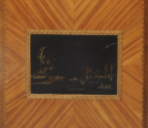Tracing origins
Japanese lacquer was present in European interiors both in the form of objects coming from Japan (for example in the shape of lacquer boxes), as well as applied to European furniture. This was especially true for Dutch furniture, probably due to the fact that the Dutch were actively trading with Japan at this time, and because Amsterdam was renowned as the capital for trading in lacquerware.
This fact hints to the Netherlands as the place of origin of our fall-front secretary. Moreover, it shows multiple similarities with another 18th-century secretary (Fig. 1), which is also believed to have been made in the Netherlands. For example, both cabinets share a similar shape and positioning of the lacquered panels.
Four lacquered panels are applied to our secretary: one at the top center, decorated with a landscape made up of rocks, trees and buildings surrounded by waves, two plates at the bottom with a decoration of canes and grass, and a central one with a decoration of flowers and geese.
We are now looking at the panel on the bottom right, which shows a delicate decoration of natural elements. Given the relative small size of the lacquer panels on this piece of furniture, we can hypothesize that they may have arrived from Japan originally in the form of a different object, such as one or several small boxes, which were disassembled into panels and then applied onto the secretary. This practice was not uncommon, and a famous example of this technique can be seen in a cabinet in the Elton Hall Collection in Cambridgeshire, United Kingdom: in this case, parts from a Japanese lacquered box named “the Buys box”, have been inserted into the cabinet. (Fig 2)

, 2005.</note>](https://micrio.thingsthattalk.net/spYPQ/views/max/128x128.cd59606e-f2b4-4548-949f-3f6704df0590.png)
](https://micrio.thingsthattalk.net/PzRcm/views/max/156x128.d32513f3-0d97-4dd2-b637-d6b79d18891c.png)
 Notice the dense and elaborate decoration in gold and mother of pearl, compared to the lacquer on the secretary.](https://micrio.thingsthattalk.net/LueXW/views/max/221x128.af49029f-817a-4396-bb77-773902a6be27.jpg)